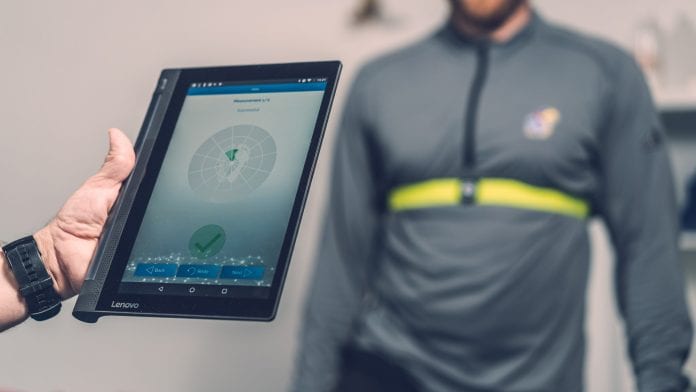
Balance evaluation is an important piece of the puzzle in sports and lower limb injuries.
Balance ability and lower limb proprioception are both related to competition level in a range of sports. Therefore, although visual and vestibular functions play important roles in balance control in sport, lower limb such as ankle proprioception, within the proprioceptive system, appears to be one of the most critical for balance control contributing to sport performance. A systematic review summarised the available evidence and suggested that poorer balance ability is an intrinsic factor associated with increased ankle injury risk. Findings suggest that ankle proprioception is closely related to balance control in sports injuries. Balance ability may be significantly affected by impaired lower limb musculoskeletal and/or proprioception in ankle or knee injuries.
So, why don’t we evaluate balance control in such a way that this kind of problem would not arise?
Balance control pilot study
Aim: The aim of this pilot study was to compare the baseline performance of athletes’ performance in SCAT5/BESS error calculation and physiotherapist’s visual/qualitative scoring system compared to effects of different visual and somatosensory conditions during balance testing in similar postures measured with sway in Ainone Balance® mobile application for balance measurement (Class I medical device/MDD).
Methods: Balance tests were administered at baseline in May 2021 to 60 healthy 18 to 20-year-old elite athletes in 12 different sports. The balancing postures were conducted similarly from SCAT5/BESS evaluation – standing feet together (Romberg position), tandem, and standing on one leg. All tests were conducted in 20 seconds on a hard and soft floor, with eyes open and closed. At the same time, sway was measured with Ainone Balance for ten seconds. The median results were used in comparison. After measuring the BESS, the athletes were divided into two groups: poor (n=12) and better (n=16). The better group reference error point was set lower than three errors in BESS and the poorer group error reference point was set to ten or higher (total errors higher than total group medium score + 1SD). The medians (Md) and standard deviations (SD) are presented as descriptive statistics. Comparisons between groups were performed using GraphPad QuickCalcs online calculator with two-tailed t-tests.

Results: All sway parameters varied with the change in both somatosensory (soft) and visual conditions. The increase from the eyes open to eyes closed condition was larger on soft foam than on a hard surface. The athletes who had higher scores in SCAT5 also had increased sway in Ainone Balance measurements. As presented in Figure 1 (Protocol A), the sway length appears to be higher and statistically significant in Romberg test in the worse group, with sway length Median 0.43 (Standard Deviation 0.13) compared to the better group Md 0.33 (SD 0.11), t(26)= 2.2029, p=0.0367. Between the groups, the highest sway length was seen in Figure 1(B) soft foam and eyes closed in tandem position. The better group sway length was 0.66 (0.24) compared to the worse group score Md 1.50 (SD 0.12). The difference was extremely statistically significant, t(26)= 4.0734, p=0.0004. The difference was only minor in sway length when standing on one leg with eyes open Md 0.46 compared to Md 0.49, but with eyes closed the difference was significantly higher, t(26)= 2.2029, p=0.0367 when comparing the better group Md 0.56 (SD 0.21) and worse group Md 1.04 (SD 0.13), as can be seen in Figure 1(D). Other results are not reported.
Conclusions: This was a pilot study of the balance tests conducted both clinically in BESS error scoring and Ainone Balance sway measurement. The results indicate that balance ability can be detected similarly to professional error/qualitative way (SCAT5/BESS) compared to sway measurements such as Ainone Balance sway measurement. It should be noted that there was a statistically meaningful difference between these groups in ‘easier balance’ positions such as feet together in soft floor or tandem positions. It has been stated that measuring sway in postural stability in the standing on one leg, eyes open, and closed condition is suitable for evaluation of balance after knee injuries.
Researchers note that further study is needed, but measuring sway seems to be a way to differentiate balance control deficits in sports in a similar way to a physiotherapist evaluation. The sway measurement is an objective way to evaluate performance difficulties and aim towards decreasing the risk of lower limb injuries and increasing the capacity of performance.
References:
Echemendia RJ, Meeuwisse W, McCrory P, Davis GA, Putukian M, Leddy J, Makdissi M, Sullivan SJ, Broglio SP, Raftery M, Schneider K, Kissick J, McCrea M, Dvořák J, Sills AK, Aubry M, Engebretsen L, Loosemore M, Fuller G, Kutcher J, Ellenbogen R, Guskiewicz K, Patricios J, Herring S. The Sport Concussion Assessment Tool 5th Edition (SCAT5): Background and rationale. Br J Sports Med. 2017 Jun;51(11):848-850. doi: 10.1136/bjsports-2017-097506. Epub 2017 Apr 26. PMID: 28446453.
Witchalls J, Blanch P, Waddington G, Adams R. Intrinsic functional deficits associated with increased risk of ankle injuries: a systematic review with meta-analysis. Br J Sports Med. 2012 Jun;46(7):515-23. doi: 10.1136/bjsports-2011-09
Han J, Anson J, Waddington G, Adams R, Liu Y. The Role of Ankle Proprioception for Balance Control in relation to Sports Performance and Injury. Biomed Res Int. 2015;2015:842804. doi: 10.1155/2015/842804. Epub 2015 Oct 25. PMID: 26583139; PMCID: PMC4637080. 0137. Epub 2011 Dec 14. PMID: 22171337.
Holder-Powell HM, Rutherford OM. Unilateral lower-limb musculoskeletal injury: its long-term effect on balance. Arch Phys Med Rehabil. 2000 Mar;81(3):265-8. doi: 10.1016/s0003-9993(00)90069-8. PMID: 10724068.
Lehmann T, Paschen L, Baumeister J. Single-Leg Assessment of Postural Stability After Anterior Cruciate Ligament Injury: a Systematic Review and Meta-Analysis. Sports Med Open. 2017 Aug 29;3(1):32. doi: 10.1186/s40798-017-0100-5. PMID: 28853022; PMCID: PMC5574832.

























